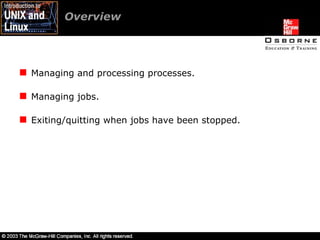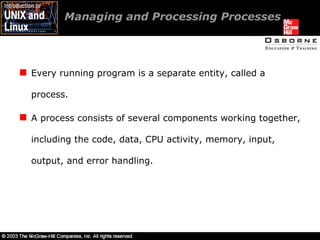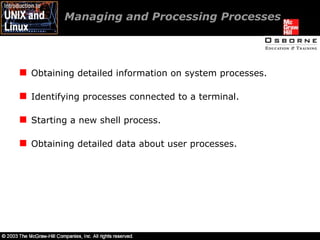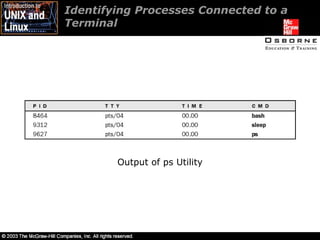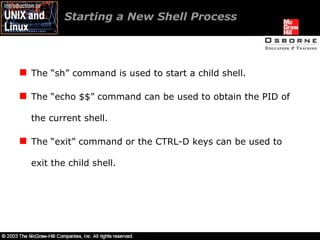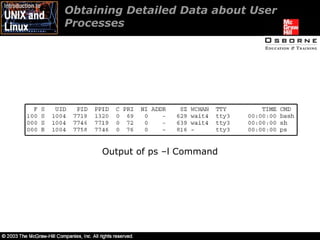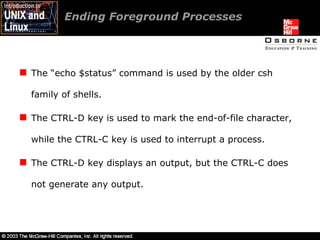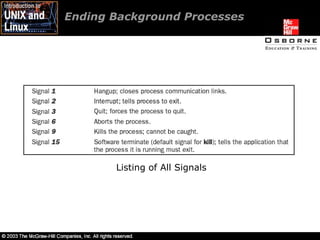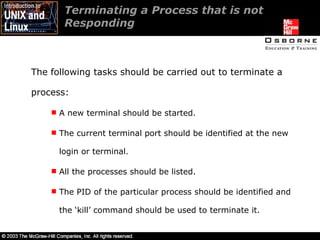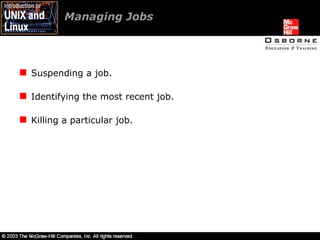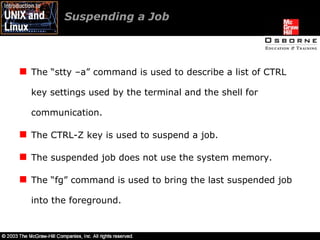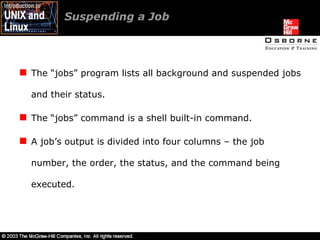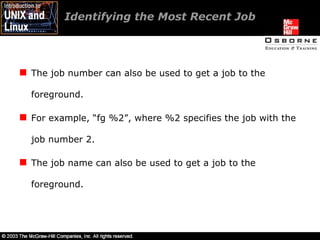intro unix/linux 10
- 1. Lesson 10-Controlling User Processes
- 2. Overview Managing and processing processes. Managing jobs. Exiting/quitting when jobs have been stopped.
- 3. Managing and Processing Processes Every running program is a separate entity, called a process. A process consists of several components working together, including the code, data, CPU activity, memory, input, output, and error handling.
- 4. Managing and Processing Processes Each process involves reading instructions, accessing computer memory, reading from input, evaluating arguments, performing calculations, and writing to output. Every process on the system has its own unique process ID number.
- 5. Managing and Processing Processes Obtaining detailed information on system processes. Identifying processes connected to a terminal. Starting a new shell process. Obtaining detailed data about user processes.
- 6. Genealogy of processes. Ending foreground processes. Ending background processes. Terminating a process that is not responding. Managing and Processing Processes
- 7. Obtaining Detailed Information on System Processes The “ps –aux” and the “ps –ef” commands can be used to get a list of all processes currently running on the system. The “ps –u $USER” command can be used to list only the processes owned by a particular user. The “ps –u root” command can be used to list the processes that are started when the system is booted up, and that are owned by the root user.
- 8. Identifying Processes Connected to a Terminal User processes must be informed of the port to which they are attached. The “tty” command can be used to determine the terminal port used by a user. The “ps –t port” command can be used to display the running processes, the shell, a process running sleep, and the process running the ps utility.
- 9. Identifying Processes Connected to a Terminal Output of ps Utility
- 10. Identifying Processes Connected to a Terminal PID – The PID, called the Process IDentification number, is a unique number assigned to each process when it gets created. CPU – It refers to the CPU time consumed by a process. CMD – The command mode contains the names of the utilities associated with each running process.
- 11. Starting a New Shell Process The “sh” command is used to start a child shell. The “echo $$” command can be used to obtain the PID of the current shell. The “exit” command or the CTRL-D keys can be used to exit the child shell.
- 12. Obtaining Detailed Data about User Processes Output of ps –l Command
- 13. Obtaining Detailed Data about User Processes Flags (F) – This field contains a number indicating the Flags or options set for a process. State (S) – It indicates the state of the process, which includes sleeping (S), running (R), idle (I), and traced (T). Size (SZ) – It contains a number indicating the size of the process in memory. Command (CMD) – It refers to the actual command being run by the process.
- 14. Genealogy of Processes Processes inherit data from their parent process. Every utility or executable file name that is typed is executed by a process that is a child of the shell process. The child process inherits data such as tty, user ID, and the current directory from the parent process.
- 15. Ending Foreground Processes The “stty –a” command can be used to display the settings for a system. The “echo $?” and the “echo $status” commands can be used to ask for the exit status sent by the process running sleep to the shell. The “echo $?” command is used by the sh and the recent csh family shells.
- 16. Ending Foreground Processes The “echo $status” command is used by the older csh family of shells. The CTRL-D key is used to mark the end-of-file character, while the CTRL-C key is used to interrupt a process. The CTRL-D key displays an output, but the CTRL-C does not generate any output.
- 17. Ending Foreground Processes The keyboard signal “quit” can be used to stop a foreground process. The “CTRL-\” keys can also be used to quit a process. The quit signal destroys the process and sometimes makes a copy of the CPU memory associated with the process at the time of exit. The copy is called a core file.
- 18. Ending Background Processes The “kill” command can be used to terminate a process running in the background. The command requires the PID of the process as the second argument. The “kill –l” command can be used to list all the kill signals available for the current system.
- 19. Ending Background Processes Listing of All Signals
- 20. Terminating a Process that is not Responding The following tasks should be carried out to terminate a process: A new terminal should be started. The current terminal port should be identified at the new login or terminal. All the processes should be listed. The PID of the particular process should be identified and the ‘kill’ command should be used to terminate it.
- 21. Managing Jobs A command-line that instructs the shell to start several processes with the output from the first connecting to the second and so on, is called a job. All modern shells allow users to start, suspend, make active, and kill the processes associated with a job.
- 22. Managing Jobs Suspending a job. Identifying the most recent job. Killing a particular job.
- 23. Suspending a Job The “stty –a” command is used to describe a list of CTRL key settings used by the terminal and the shell for communication. The CTRL-Z key is used to suspend a job. The suspended job does not use the system memory. The “fg” command is used to bring the last suspended job into the foreground.
- 24. Suspending a Job The “jobs” program lists all background and suspended jobs and their status. The “jobs” command is a shell built-in command. A job’s output is divided into four columns – the job number, the order, the status, and the command being executed.
- 25. Identifying the Most Recent Job The “fg %+” is used to bring the most recently suspended job to the foreground. The “fg %-” is used to bring the second most recently suspended job to the foreground.
- 26. Identifying the Most Recent Job The job number can also be used to get a job to the foreground. For example, “fg %2”, where %2 specifies the job with the job number 2. The job name can also be used to get a job to the foreground.
- 27. Killing a Job The “kill %+” command is used to kill the most recent job in the job list. The job number can also be passed as an argument to kill that particular job. The job name can also be passed as an argument to kill a job. Care should be taken while killing a job. We must not kill wrong jobs.
- 28. Exiting/Quitting When Jobs Have Been Stopped Job control is a very useful method of managing processes. UNIX job control provides a method of warning the users of stopped or running background jobs when an attempt is made to log out or exit a process. It logs out without warning when we issue the same command again, resulting in loss of unsaved data.
- 29. Summary Programs running in a system are executed by a process that reads the appropriate code and accomplishes the tasks. All the processes have their own unique PID, the PID of their parent, an owner, group, memory, code, input, output, error, and their tty port.
- 30. A command-line that consists of one process or a series of processes connected by pipes is called a job. The kill command terminates processes identified by either their process ID or job number/job name. Summary

